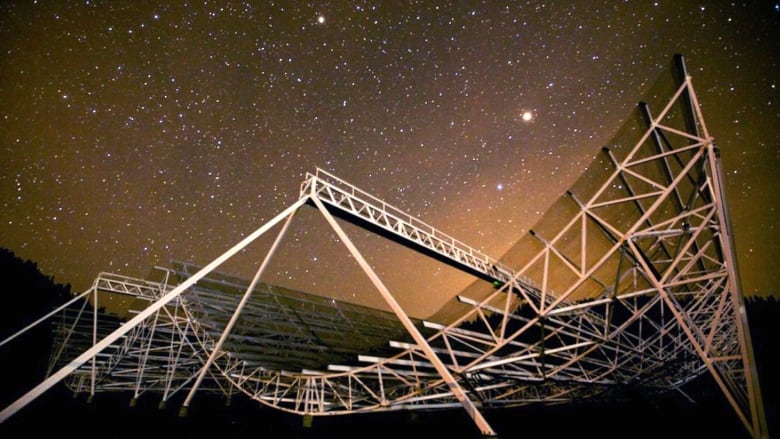- Get link
- X
- Other Apps
- Get link
- X
- Other Apps
They are named fast radio bursts, or FRBs, and these odd, brief signals from space are covered in mystery. But thanks to Canada's biggest radio telescope, astronomers are finding more of them in their hunt to know what makes these objects tick.

The first FRB was found in 2007 by an astronomer and his apprentice while studying 2001 data gathered from the Parkes Observatory in New South Wales, Australia. Since then, many more have been discovered. As to what is producing these signals, researchers have yet to learn. But these momentary signals that are journeying the cosmos — and last only a millisecond or so — had another surprise: some of them repeated.
The first of these repeating FRBs were found by McGill PhD student Paul Scholz in 2015. A second one was detected last January. And the list is getting lengthier. In a recent study, submitted to the Astrophysical Journal Letters and pre-printed on arXiv.org, a group of Canadian researchers disclose that the Canadian Hydrogen Intensity Mapping Experiment (CHIME) telescope discovered eight more repeating FRBs. The discoveries are a significant step in better understanding what is generating these powerful signals and where precisely they are coming from.
“The first biggest conclusion [from the paper] is that this is not an anomalous phenomenon. This is for real,” said Victoria Kaspi, an astronomer at McGill University and the Canadian Institute for Advanced Research (CIFAR). “It just takes time and patience to find them. And two, it offers the opportunity to localize them, and that's huge in the FRB field.”
The CHIME apparatus cannot be both sensitive and accurate in its discoveries, which means it can’t pinpoint the signal. In its place, its job is to detect as many as it can. Finding their precise position is up to other telescopes.
“Discovering eight sources like this is so important because it says we have a lot more repeating FRBs and can figure out the environments and the galaxies these FRBs are located in if we follow them up with other telescopes,” said Pragya Chawla, co-author of the paper and a PhD student at the McGill Space Institute.
Of the 10 reocurring FRBs, only two have been traced back to their location of birth: one is in a dwarf galaxy and the other, in a spiral galaxy. FRBs are a hot topic in the astronomical world, mostly because they're a fairly new discovery and the mechanism responsible isn't understood.
"We think we understand what's in the cosmos," Kaspi said. "But fast radio bursts were a total surprise. Nobody expected them. Nobody predicted them. Really, it was technological advancements that allowed us to see this. And I think it's really interesting that we're still learning very basic things about what's going on in the universe."
Since they produce such intense energy, some theories propose that the source is a neutron star, a small dense star left over after a supernova. Another theory proposes it could be a magnetar, a star like a neutron star, but with an exceptionally powerful magnetic field. Although the known FRBs — both the repeaters and apparent non-repeaters — are thought to initiate in other galaxies, one of the newly discovered ones appears to be nearer than the others, maybe even within the Milky Way. Though, Chawla said that if it were to be detected within Milky Way that “it would be very astounding”.
“Because we know a lot of neutron stars within our own galaxy that emit such pulses, but none of them have been seen to be found that far at the edge of our galaxy.”
CHIME has been quite effective in its hunt for these mystifying objects, but the even better news is that the telescope is not running on full power: there is still the need to better calibrate it. Once that is done, it's expected that even more FRBs will be discovered on a daily basis. And that means more data to deliver other astronomers with the apparatuses of unravelling their mystery.
“I think the upcoming year will be a really good one for FRBs,” Kaspi said. “Are we going to know the answer in a year's time? I don't know. I don't know. Maybe. But I think we will have made significant progress in a year.”
- Get link
- X
- Other Apps
Comments
Post a Comment